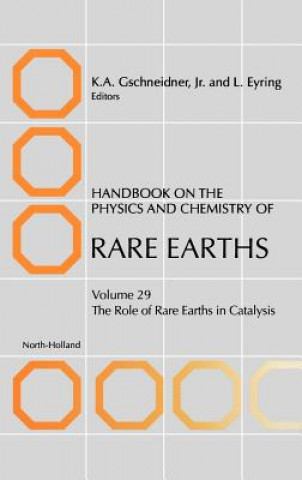
Livrare
Consilier de cumpărături





Nu se pretează? Nu contează! La noi puteți returna bunurile în 30 de zile
 Voucher cadou
orice valoare
Voucher cadou
orice valoare
Cu un voucher cadou nu veți da greș. În schimbul voucherului, destinatarul își poate alege orice din oferta noastră.
Handbook on the Physics and Chemistry of Rare Earths
 engleză
engleză
 931 b
931 b
30 de zile pentru retur bunuri
Ar putea de asemenea, să te intereseze


Among the numerous applications of the rare-earth elements, the field of catalysis accounts for a large number. Catalysis represents approximately 20 per cent of the total market sales of rare earths worldwide. As a matter of fact two main applications have been prominent in the last decades: zeolite stabilization for fluid cracking catalysts, and automotive post-combustion catalytic treatment. The oldest use of rare earths in catalysis deals with the structural and chemical stabilization of the zeolites for petroleum cracking applications. For a long time this has been an area of application for non-separated rare earths. The addition of several percent of rare earths in the pores of the zeolite results in a strong surface acidity, which is essential for an efficient conversion of high-weight molecules into lighter species, like low-octane fuel, even in the very aggressive conditions of the petroleum industry. The popular demand for high-quality air in spite of the traffic congestion in large cities resulted in larger and larger constraints in the emission exhaust from cars. Thus highly efficient catalysts have had to be designed, and due to the combination of its redox properties and very good thermal stability, cerium oxide has been since the beginning, early in the 1980s, a major component of the three-way catalysts (TWC) now used in all modern gasoline cars. The future of rare earths in catalysis is probably bright. The fact that approximately 400 patents are applied for yearly in the area since 1992 is an illustration of a very active area. Usage of rare earths in catalysis is expected to grow due to their highly specific properties. Instead of the physical properties used in electronic applications, one deals now with redox properties, water and thermal stability, coordination numbers and so forth. The rare earths are so specific in these properties that their use can hardly be avoided, not only for the beauty of academic studies but also for the development of industrial applications with immediate influence on everyday life. Careful control of the synthesis conditions and the definition of optimum composition in each case are the keys to the preparation of highly performing compounds for catalytic applications. They must actually be considered as high performance products with functional properties, and not just chemical species. Chapters devoted primarily to catalysis have been published in earlier volumes of the Handbook. In this volume several more are added. The first is an extension of the earlier chapter 43, on interactions at surfaces of metals and alloys, to reactions such as hydrogenation, methanation, ammonia synthesis, saturated hydrocarbon reactions, dehydrogenation of hydrogenated materials, hydrodesulfurization, and carbon monoxide oxidation. The second chapter reports on the wide variety of catalyzed reactions involving metals and alloys in the innovated form of metal overlayers or bimetallic compounds with some transition metals produced from ammonia solutions. This is followed by a chapter on catalysis with mixed oxides usually having perovskite or perovskite-related structures. Then follows a comprehensive discussion on the background and current role of cerium oxide and associated materials for post-treatment of exhaust gases for pollution control. These three-way catalysts (TWC) are designed to render harmless the CO, NOx, and unburned hydrocarbons from internal combustion engines. The next chapter considers the wide field of zeolite catalysts containing rare earths from their historic use in petroleum refining in the 1960s to other petrochemical and fine chemical applications today. The final chapter documents the use of the triflates (the trifluoro-methane-sulfonyl group which is a hard Lewis acid in both aqueous and organic solutions) as versatile catalysts in carbon-carbon bond-forming reactions. Their stability in the presence of water, in spite of their being hard Lewis acids, enhances their growing usefulness.
Informații despre carte
 engleză
engleză




 Cum să cumpăr
Cum să cumpăr


















